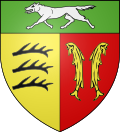Thulay
In today's world, Thulay has become a topic of great relevance and interest to many people. Whether due to its impact on society, its relevance in history, or its influence on popular culture, Thulay is a topic that does not go unnoticed. Over the years, Thulay has been the subject of numerous studies, debates and analyses, demonstrating its importance in different areas. In this article, we will further explore the importance of Thulay and its impact in various areas, in order to better understand its relevance in today's world.
Thulay | |
|---|---|
 The town hall in Thulay | |
| Coordinates: 47°25′30″N 6°51′44″E / 47.425°N 6.8622°E | |
| Country | France |
| Region | Bourgogne-Franche-Comté |
| Department | Doubs |
| Arrondissement | Montbéliard |
| Canton | Maîche |
| Intercommunality | Pays de Montbéliard Agglomération |
| Government | |
| • Mayor (2022–2026) | Eric Salas[1] |
Area 1 | 2.23 km2 (0.86 sq mi) |
| Population (2022)[2] | 206 |
| • Density | 92/km2 (240/sq mi) |
| Time zone | UTC+01:00 (CET) |
| • Summer (DST) | UTC+02:00 (CEST) |
| INSEE/Postal code | 25562 /25310 |
| Elevation | 394–541 m (1,293–1,775 ft) |
| 1 French Land Register data, which excludes lakes, ponds, glaciers > 1 km2 (0.386 sq mi or 247 acres) and river estuaries. | |
Thulay (French pronunciation: [tylɛ]) is a commune in the Doubs department in the Bourgogne-Franche-Comté region in eastern France.
Geography
Thulay lies 2.5 km (1.6 mi) from Hérimoncourt on the slope of the Blamont plateau.
Population
| Year | Pop. | ±% |
|---|---|---|
| 1962 | 93 | — |
| 1968 | 95 | +2.2% |
| 1975 | 105 | +10.5% |
| 1982 | 119 | +13.3% |
| 1990 | 140 | +17.6% |
| 1999 | 172 | +22.9% |
| 2008 | 231 | +34.3% |
| 2012 | 226 | −2.2% |
See also
References
- ^ "Répertoire national des élus: les maires" (in French). data.gouv.fr, Plateforme ouverte des données publiques françaises. 4 May 2022.
- ^ "Populations de référence 2022" (in French). The National Institute of Statistics and Economic Studies. 19 December 2024.
External links
- Thulay on the regional Web site (in French)



